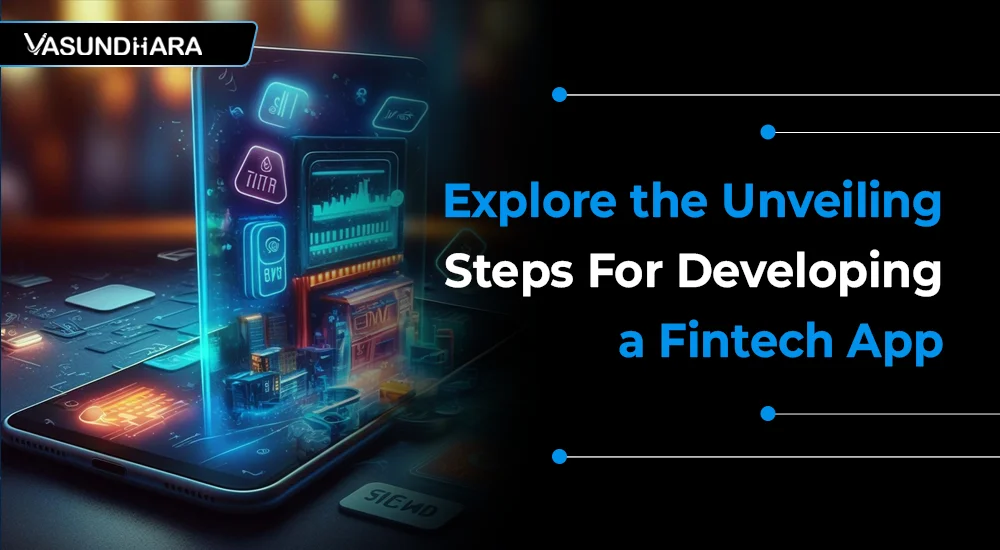Explore the Unveiling Steps For Developing a Fintech App


- Feb 21, 2023



The Fintech industry is rapidly expanding, providing many business opportunities to early adopters. Every day, new financial applications enter the market.
As investments in Fintech are expected to rise dramatically in the coming years, it is clear that banks and Fintech firms are becoming direct competitors in the finance industry.
As a result, customers can select from a wide range of cutting-edge apps that provide intriguing solutions to their problems.
Because of open banking and the increasing use of smartphones in our daily lives, businesses may create a Fintech app to give customers a simple way to manage their money without ever having to visit a bank.
This blog will help you understand the current market trends for Fintech applications, the top features of Fintech apps, types of Fintech apps, steps to create a Fintech app and the cost to build a Fintech app.
Let's get started right away!
Because of the growing demand for reliable solutions that simplify daily life, innovative technologies have made their way into the financial sector.
It has also become one of the most significant global business trends. Let's face it, how many of us still think it's reasonable to go to the bank and stand in long lines when you can settle things with your smartphone?
This has resulted in a slew of Fintech startups all over the world. As a result, financial technology is actively transforming and modernizing a wide range of traditional systems with innovative Fintech app ideas. Here are some interesting statistics:
The global Fintech market reached a value of more than USD 194.1 billion in 2022 and is anticipated to increase at a CAGR of 16.8% from 2023 to 2028 to surpass USD 492.81 billion.
By 2026, it is expected that the transaction value for the global digital payments market would be approximately USD 11.29 trillion.
By 2023, it is anticipated that the worldwide Fintech market would grow to $305.7 billion.
The value of the global Fintech market exceeded USD 194.1 billion in 2022, and it is anticipated to increase over the forecast period of 2023–2028 at a CAGR of 16.8% to surpass USD 492.81 billion.
In terms of size and income, digital payments appear to be the most promising of all Fintech areas.
Fintech apps serve a variety of industries and assist consumers and businesses in providing seamless financial services and operations.
Here are a few examples of popular Fintech applications: The following are the main types of Fintech applications you can create:
Digital banking apps enable online interaction with a financial institution. Customers can use this software to perform banking-related tasks, such as opening an account, transferring funds, or making loans.
Payment applications enable online transactions and money transfers. PayPal is an example of such software, which is extremely popular due to its convenience.
These applications do not require the employment of middlemen. They only allow transfers between two individuals, and transfers are usually completed quickly.
Bypassing middlemen like brokers, these apps enable investors and traders to invest and trade straight from their smartphones.
This type of Fintech app is typically used in the stock, forex, and capital markets.
Personal finance apps enable users to track their income and expenses by categorizing them as transportation, utilities, etc. You no longer need to keep track of costs in a notebook or use Excel sheets with this software.
These solutions typically provide simple tools and a gamified experience.
Applications that enable digital insurance are designed to make the issuance of insurancepolicies more accessible and faster.
As a result, they improve the efficiency of interactions between customers and insurance agents. Such software also aids in the handling of customer claims and lowers the associated fraud rate.
A digital wallet is software that enables users to receive payments, send money online, and store money. A prime example of one of these applications is the well-known Apple Wallet.
Keep reading on to this blog to know the steps on how to build a Fintech app.
Any mobile application with exceptional features provides a unique user experience. If you're trying to turn your Fintech mobile app concept into a working application, here's a list of some of
the top Fintech app development features you should think about including in your mobile app.
Several private banking and financial transactions are carried out using a Fintech application. As a result, the first responsibility of any Fintech application is to ensure the confidentiality and security of the data of its users.
Fintech app developers include features such as two-factor authentication, blockchain, biometrics, encryption, and many other security measures to protect data from unauthorized access.
In the majority of Fintech apps, users receive information about their earnings, spending, and daily transactions in a concise manner. However, data visualization is one of the aspects that could give your Fintech app a competitive advantage.
This will visually represent all aspects, including stock charts, payment histories, and spending. As a result, it is frequently included as a required component when developing a Fintech application.

Voice assistants enable the most powerful and popular financial application functionalities to emerge. The voice assistant is the current trend in financial apps.
Customers can use the programme without having to open it thanks to voice assistants such as Siri, Google Assistant, and others.
Most Fintech apps include some payment gateway feature; to do so, these programmes interact with third-party payment gateway providers such as PayPal.
The secure payment gateway of a Fintech application is thus one of its key features.
There must be a feature that allows users to tour the entire application, demonstrating the functionality and capabilities of the Fintech app, simplifying the use of a Fintech app, and making all functions quickly accessible to users.
This must be concise and informative for users, including those unfamiliar with money, to have a positive experience.
Now that we’ve taken a deep dive in the top features of Fintech apps, and types of Fintech apps solutions, it is time to learn how to build a fintech app in 6 easy steps.
Before you begin the development process for financial software, you must first identify a speciality. Finding the right niche may take some time and effort, but it is critical because it will allow you to simplify the process and create a highly scalable Fintech application.
Throughout the niche selection process, the type of Fintech app, the method of building a Fintech app, and the targeted location must all be determined.
Consider the application's intended use, such as mobile banking, money management, crowdfunding, or anything else. After determining the objective, the next step is identifying the target audience and their needs.
All this research will help ensure a smooth and streamlined development process.
During the competitor analysis stage of the development process, you should ensure that you hire the best Fintech mobile app development company that can help you develop an app that stands out in the competition.
Before conducting a competition analysis, it is necessary to conduct extensive market research on existing apps to determine their benefits and drawbacks.
By identifying flaws in your competitors' financial app designs, you can create an app that fixes all those issues and provides consumers with a richer, more frictionless experience.
It will help one gain an advantage over competitors and expand one's consumer base.
Get the right technology stack in place to build a successful financial application. Because each Fintech project is different and unique, a customized technological stack is necessary to meet the specific project needs and objectives.
Depending on the type of application and the features included, a diverse set of tools and technologies are required for the front and back end.
A few key technologies are used in developing Fintech applications, including Java, Swift, Ruby, C#, Python, C++, and Kotlin. You can use Swift or Objective C for iOS, Kotlin and Java for Android.
You can also use it to lower the overall cost of developing Fintech apps and shorten the time it takes to launch them if you choose the right technology stack.

Compliance in Fintech application development is far more thorough than in other applications. Maintaining publication standards for the Google Play Store and the Apple App Store is insufficient in this situation.
Based on the target market selection, thorough compliance research is required to identify potential governing rules, constraints, and legal barriers.
All such legal considerations should be identified, and the development process modified as needed. Understanding what is permissible under the applicable rules and regulations is critical.
Because laws change to reflect compliance and financial protection measures when a business relocates, the Fintech app development firm must be well-versed in the law.
Digital signature certifications, Know Your Customer (KYC), and other critical concepts are just a few examples. Make sure to complete this step to ensure compliance is maintained thoroughly.
| Read More:- How Much Does it Cost To Develop a Fintech App |
It is prudent to test your idea before embarking on a lengthy project. A minimum viable product (MVP) version is used to accomplish this. A minimum viable product (MVP) is a proof of concept with only enough functionality for beta testers.
It increases the likelihood that you will create a finance app that benefits its users. Furthermore, promoting your software and attracting investors is an excellent opportunity. With an MVP, you get early feedback, which reduces the likelihood of your idea failing.
The development of your app continues even after it has been released. When you start receiving insightful comments, it's time to keep improving and growing. Vasundhara Infotech has extensive experience in developing and maintaining sophisticated Fintech systems.
Following that, assistance is critical. When speaking with any of your clients, your technical team should always respond quickly and courteously.
Users rate an app higher when it responds to user issues rapidly and effectively. It is a critical requirement for large and well-known apps, where even minor unaddressed flaws may completely ruin everything.
The disruptions caused by Fintech in recent years by giving customers better alternatives to traditional banking solutions have generated a lot of excitement in the banking and financial sectors. Various types of enterprises are starting to see the great potential and importance of these new technologies, as evidenced by the data displayed above.
To stay in business, financial institutions must offer a service that lets customers manage their money online with ease. A crucial first step is getting started.
Vasundhara Infotech achieves the perfect balance between quality and affordability in each of its endeavors.We manage a varied portfolio of both domestic and international clients in an effort to provide scalable and reliable solutions to its clients from a variety of backgrounds.
We can assist you in creating a Fintech solution that properly satisfies client demands while remaining affordable. We are a mobile app development company with years of expertise creating unique solutions.
To get in touch, send us a message. We're happy to answer your questions if you need any assistance.
Copyright © 2025 Vasundhara Infotech. All Rights Reserved.